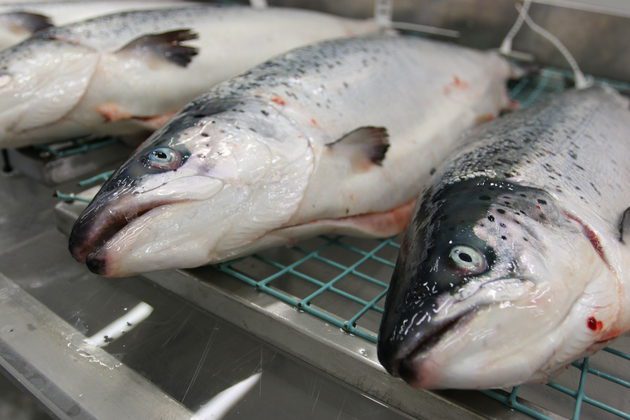High demand results in little variation in salmon products
Press release from Nofima

High salmon prices mean that people are less willing to pay extra for new sustainable products. However, extensive studies in important salmon markets show that eco-labels and various quality characteristics are desired by consumers.
Most of the salmon exported from Norway is sold as whole gutted salmon. Over the past four years, market researchers have investigated the opportunities Norwegian salmon producers have to sell a wider range of salmon products.
In several studies, researchers have interviewed salmon producers, buyers and consumers about their preferences regarding salmon products. They have mapped existing salmon products and prices, and investigated different labelling schemes and quality characteristics in different markets. There is little to suggest that the range of products is going to change much anytime soon.
“When customers want more of the salmon that is being produced, and the price is high, there isn’t much motivation on the part of the producers to invest in the development of new products”, says senior scientist Geir Sogn-Grundvåg.
Last year’s exports were at a record high, with as much as 1.3 million tons of Norwegian salmon valued at NOK 81 billion. Over time, however, profitability will probably normalise, and it will then be important to create a wider range of products to ensure stable prices and profitability. It will also be important to find new markets for existing products.
Qualidiff
Quality-based differentiation of salmon
Can we increase the value of salmon by emphasizing salmon quality in different ways?
Not willing to pay more for different qualities
When manufacturers make different products today, it is mainly just the external characteristics that distinguish them from each other, such as eco-labels, their own brands, and the origin of the fish. There is little about the salmon product itself that makes it different from the neighbouring product on the store shelf.
A large proportion of the whole and gutted salmon sold from Norway is further processed in other countries. In interviews with buyers, several of them say that they would like to see different characteristics in the salmon they get from Norway.
“For example, salmon products could have different fat contents or different types of fat, as a result of breeding and different types of feed. But such adaptations are both expensive and demanding because the fish would have to be kept separate during production. And the companies that further process the fish are reluctant to pay more for salmon that have different qualities”, says Sogn-Grundvåg.
Eco-labels result in higher prices and longer product life
In order to stand out positively, manufacturers use labelling schemes that refer to positive environmental and sustainability characteristics of the product. How important are these types of eco-labels for consumers when making their choices in stores?
The researchers have conducted several studies in a number of export markets, and in particular they have investigated various conditions regarding the ASC (Aquaculture Stewardship Council) and MSC (Marine Stewardship Council) brands. These can be used on products that are certified according to a number of requirements regarding sustainable production and sustainable fishing.
“In a study in Denmark, researchers found great variation in the type of salmon products that consumers preferred. In addition, characteristics involving convenience, i.e. that the product is easy to use, were very important in terms of which products the consumers chose to buy”, says Sogn-Grundvåg.
Products that are eco-labelled are chosen for many different reasons.
“In Germany, researchers found that 63 percent of consumers who choose eco-labelled salmon do so because they want to buy sustainable food, while 24 percent do so because it gives them a sense of doing something good”, says Sogn-Grundvåg.
However, will consumers continue to choose eco-labelled products if they cost more? A study of farmed rainbow trout, tilapia and pangasius products with ASC labels showed that the ASC label results in a higher price, but that this also varies between the three species. ASC-labelled rainbow trout cost almost nine percent more than similar trout products without the label. With regard to tilapia and pangasius, the price increase was just under six percent.
The lifetime of the products, i.e. how long the product is retained in the stores’ product range, is important in terms of all the time, effort and money that go into product development, sales and marketing.
“By studying wild salmon and whitefish products in UK supermarkets, we saw that the MSC label contributes significantly to increased product life of whitefish compared to products without such labelling. But we also found that this varies between supermarkets.”
The overall results of the various studies show that it takes more than eco-labels to succeed with salmon products. With regard to salmon, the chains’ own brands and producer brands were most important for increasing product life. A survey in Japan showed that as much as 20 percent of the people who took the survey had not heard of sustainability labelling.
‘Quality’ means different things in different markets
Consumer perceptions of quality were the starting point for in-depth interviews with consumers in the US and Japan. What thoughts and associations does one make when choosing which food to eat, and what does one think of when we talk about good quality? The insights gained from these interviews indicated that the perception of quality was influenced by consumers’ knowledge about food production, processing and cooking, what kind of food they grew up with, and what sociocultural environment they belonged to.
Both Japanese and American consumers viewed salmon as a quality product, but for different reasons. The Americans believed that wild salmon is good for your health, and salmon fishing reminded them of an activity they grew up with. The Japanese, on the other hand, emphasised that buying and eating exclusive wild salmon products gave them ‘peace of mind’ and a good quality of life.
In November 2020, the researchers sent out an online survey to consumers in the United States, Japan and France, and received responses from 1000 people in each country. When asked which quality criteria were most important to them, both the Americans and the French highlighted that good texture, nutritional content and colour were the most important, while the Japanese thought convenience and nutritional content were most important.
What constitutes ‘common’ knowledge about salmon characteristics also varies. Salmon is an important source of the Omega-3 fatty acids DHA and EPA, which our bodies need.
“Surprisingly many people in France and the United States did not know what DHA and EPA are, while they believed that omega-3 content was important. In Japan, consumers were more concerned about DHA and EPA than with Omega-3”, says Research Director Pirjo Honkanen, who has participated in the project.
It was also somewhat surprising that consumers did not think it was important that the salmon has not been frozen. Cold storage of salmon products can therefore be a great opportunity for producers who want to try out more products, and to contribute to more sustainable transport of salmon. The consumer survey also provided useful information regarding marinated salmon products, which are demanding to produce. Consumers showed little interest in such products, as they suspect that the marinade hides signs of poor quality.
How important is the origin of the fish?
A lot of resources are spent on strengthening the ‘Norwegian salmon’ or ‘seafood from Norway’ brands. But what do we really know about consumers’ attitudes to where salmon comes from? This was also a topic in the aforementioned survey among consumers in the United States, France and Japan.
“Many people prefer salmon from their own country, in fact as much as 67 percent in Japan, 34 percent in the US and 25 percent in France. They are also willing to pay more for salmon from their own country”, says Honkanen.
The salmon’s origin is also associated with higher quality in terms of sustainability, freshness, health, safety, taste, naturalness and convenience. Especially in France and Japan, salmon from their own country is considered to be of better quality when it comes to sustainability, safety and naturalness. However, the researchers also found a segment in these countries that prefers Norwegian salmon, and they believed that Norwegian salmon has exactly the same quality characteristics: that it is sustainable, safe and natural.
So, in what ways can a salmon producer use this knowledge?
The project tells us something about how the quality of salmon fillet products can be communicated. The choice of words one makes is not without significance. The research revealed that ‘sushi grade’ in both the US and Japan is a symbol of high quality, and the ‘premium’ quality label is also valued, especially in Japan.
“In these markets, it can therefore be a good idea to communicate with customers using perspectives related to aesthetics and sushi grade pricing”, says project manager Geir Sogn-Grundvåg.
The varying knowledge of Omega-3 compared to DHA and EPA also indicates a different focus in communication in the different markets. Producers can benefit from familiarising themselves with what applies in the markets they want to deliver to.
“It is also worth noting that many prefer salmon from their own country. This indicates that land-based production closer to the markets can become an important competitor for Norwegian salmon if the production of salmon on land increases”, says Sogn-Grundvåg.
Facts about the research:
The research was carried out in the four-year Qualidiff project, funded by the Research Council of Norway. Nofima has been the project manager, and research partners include the University of Florida, the University of Stirling, and the University of Stavanger.
The project has resulted in a number of scientific publications based on a number of different data sources:
- interviews with industry actors in the salmon value chain in Norway, Poland and Germany
- Interviews with consumers in Germany, the US and Japan
- online survey among consumers in the US, France and Japan
- econometric analyses of various retail trade datasets in the UK, Germany and Denmark, and datasets based on trade statistics.
The different datasets have been analysed in different ways and have been published in scientific journals with different academic orientations. This considerable range of data material, analytical methods and publication channels help shed light on the project’s issues from different angles and is considered a significant strength of the project.
Contact person

Geir Sogn-Grundvåg
Senior Scientist
+47 77 62 90 91
[email protected]
Originally published on 8 December.
Announcements are published as a service to readers. The sender is responsible for all content.
Announcements for publication can be submitted to [email protected].